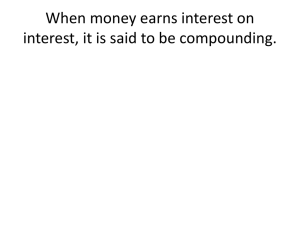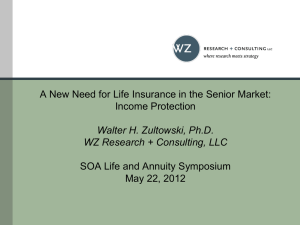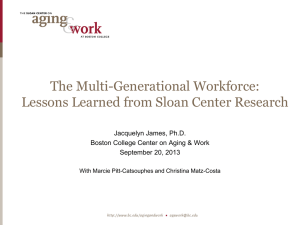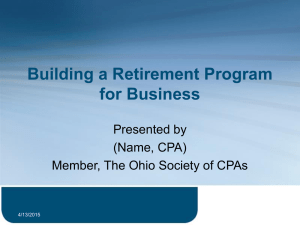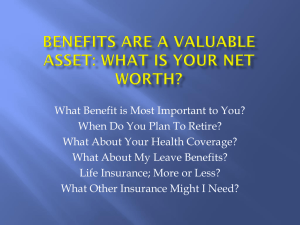Balancing Work and Life - Designing The Age Friendly Workplace
advertisement
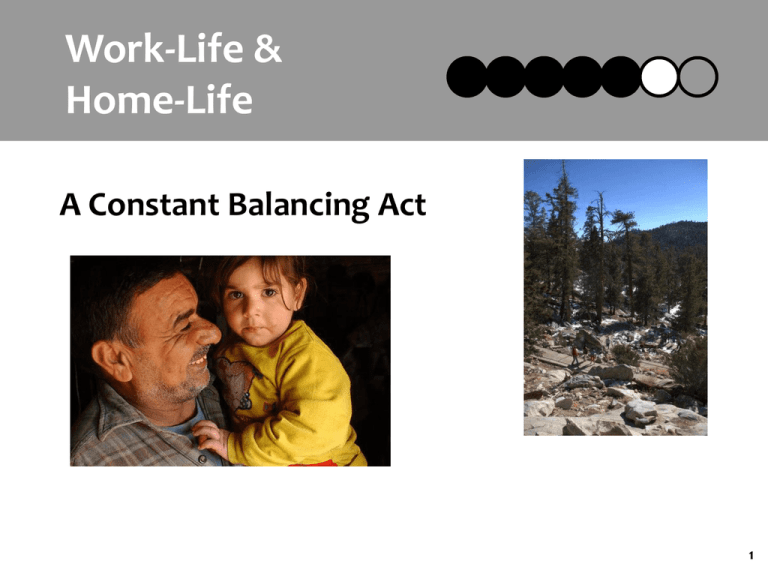
Work-Life & Home-Life A Constant Balancing Act 1 Work and Retirement A Discussion Why do we work? Why do we retire? 2 Key Points Balancing Work-Life and Home-Life • It’s time to rethink the relationship between work and retirement • Flexible Work Options: There is more than one way to work toward full retirement • The way work is arranged at your organization will affect how your workforce ages • There are society-level factors that will impact how your workforce ages 3 Traditional Work Arrangement • 40 hours per week • Standard schedule • In the same location – Some traveling • Employer-based health insurance • Costs of living are paid for with your income 4 Traditional Retirement • ~ 62-65 years of age • You wake up one day without a job • Medicare covers your health care • Social Security and retirement savings cover your costs of living 5 Approaching Retirement A Variety of Preferences Older Workers' Preferences for the "Next Stage" 8% 21% 38% 5% Cycle In and Out Part-Time Start a Business Work Full Time Never Work Again Something Else 11% 17% Source: Harris Interactive & Dychtwald, The Merrill Lynch New Retirement Survey, 2005 6 Approaching Retirement Should I Stay or Should I Go? Older Workers' Preferences for the "Next Stage" 8% 21% 38% May prefer to continue with Cycle In and Out current employer Part-Time Start a Business Would prefer to Work Full Time leave current Never Work Again employer Something Else 5% 11% 17% 7 Phased Retirement Flexibility in Action Traditional Retirement Full Time Work Full Retirement @ ~ 65 years Phased Retirement Full Time Work Transition Phase Full Retirement 8 Phased Retirement What Happens During the Transition? • Worker reduces the amount of time at work – – – – – – Gradual reduction in hours (e.g. 40, 30, 20, 10 hrs/week) Part-time work Seasonal work Sabbaticals Contract-based work Job-sharing • Can happen with the long-time employer or an entirely new employer • Can be a formal program 9 Phased Retirement Opportunities and Challenges • Health Benefits – Health care costs have increased dramatically over the past several decades – Health care costs will likely present a challenge for organizations that employ older workers – Wrapping health insurance around Medicare might reduce employers’ health care costs for “phasers” – Legally complex 10 Phased Retirement Opportunities and Challenges • Pension and Retirement Funds – Reduced time at work would lead to reduced income for older workers – Drawing savings during transition phase may supplement a worker’s reduced income – Legal restrictions vary by types of savings plans • Defined benefit • Defined contribution 11 Flexible Work Options A Step Back • Part-time work • Seasonal work • Job sharing 12 Flexible Work Options Schedule Work Load Location Responsibilities Tradition Flexible Option Examples 9-to-5 4 x 10 hr shifts 40 hrs/week Part-Time Workplace Home (telecommute) Alone Shared 13 Variation Differences Between Industries • Some industries are inherently more “flexible” than others – Computer programming vs. factory work – Industries that hire independent contractors on a contingent basis • Construction • Hair salons • Knowledge-based occupations 14 Work Arrangements What To Do • Consider what makes sense for your workplace and your workforce… – – – – Creating new flexible options Developing a formal phased retirement plan Legal advice Promoting flexible options that already exist 15 Break 16 Society-Level Factors A Bird’s Eye View • What happens if you want to develop a phased retirement program and can’t? • What happens if there aren’t enough primary care providers? • There are social factors that determine how your workforce will age 17 The Legal Framework Laws Relevant to the Aging Workforce • Tax & Benefits Laws – ERISA – IRS • Discrimination Laws – ADEA – ADA • Health and Safety Laws – OSHA – Workers Compensation • Family Medical Leave Act • Social Security 18 Community Resources • • • • • Public transportation Schools and colleges Elder care facilities Health care providers Child care 19 Social and Community Resources What To Do • Identify what your organization’s priorities are • When the social framework is a barrier (e.g. laws are too narrow) – Let your legislators know where you stand – Lobby for change • When the social framework is an asset (e.g. a child-care facility close to your workplace) – Increase awareness among your employees – Provide incentives to utilize beneficial programs 20 Work & Life Balance A Review of the Key Points • It’s time to rethink the relationship between work and retirement • Flexible Work Options (e.g. phased retirement) give employees more than one way to work toward full retirement • You can organize work to influence how well your workforce ages • Be aware of the society-level factors that will impact how your workforce ages 21 Time for a Break… 22 Work/Life Balance What To Do1 1. 2. 3. Identify your priorities Create a plan to address your priorities Implement your plan and build on it 1 Planning approach adapted from “The Breakthrough Strategy,” developed by Robert Schaeffer 23 1. Identify a Work/Life Balance Priority What Will Make a Difference? • What Is Your Priority? – What’s important for the future of your organization? – What will people in your organization really care about? Community Resources Phased Retirement Part Time Work Job Sharing Seasonal Work 24 2. Create a Plan How Do You Achieve Your Objectives? • How will you measure “success”? ________ – Pick a good way to measure your top priority – How much will you change? ________ – Hint: Start small to generate momentum • Do you have a baseline? • Who is accountable? – Who is the champion? _______________ – Is it a team effort? If so, who’s on the team? 25 2. Create a Plan How Do You Achieve Your Objectives? • What is the timeline? – When will it all be done? ____/ ____/ ______ – How often will you need to meet for progress updates? • What, exactly, do you need to do to make it happen? – – – – – Step 1:__________________________________________ Step 2: _________________________________________ Step 3: _________________________________________ Step 4: _________________________________________ Etc. 26 2. Create a Plan How Do You Achieve Your Objectives? • What might get in the way? • How will you respond? Challenge Response 27 The Age Friendly Workplace Type of Goal Goal How It Will Who Will When It Happen Ensure It Does Will Finish Challenges & Responses The Work Environment Health Promotion Work/Life Balance - In the Workplace - In the Community 28

